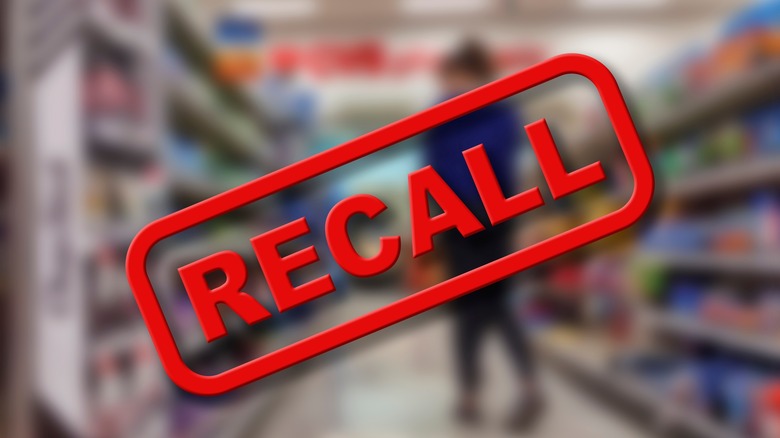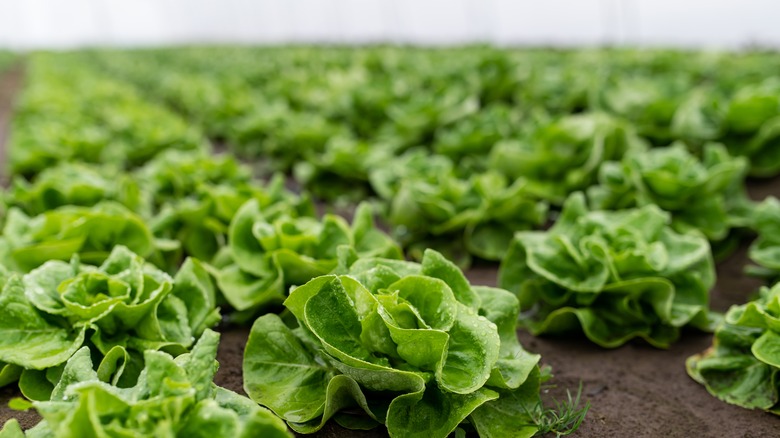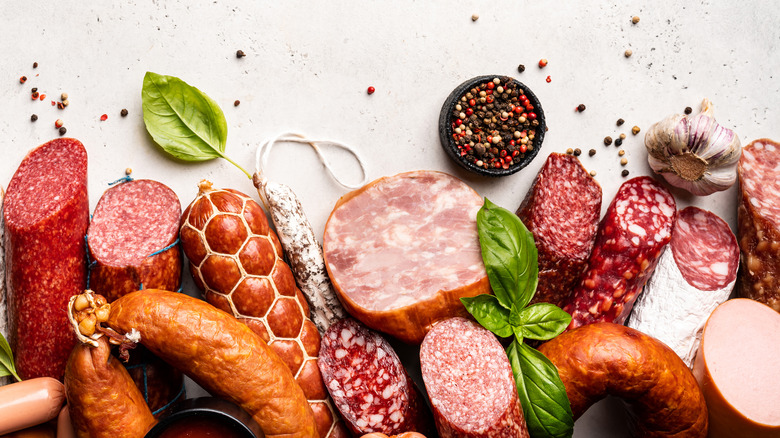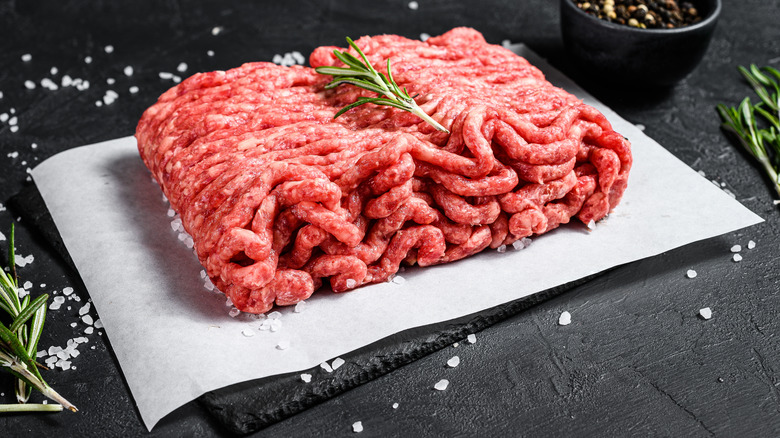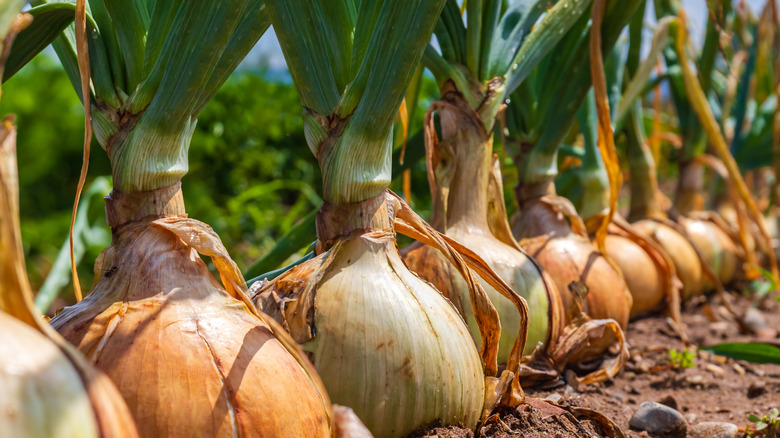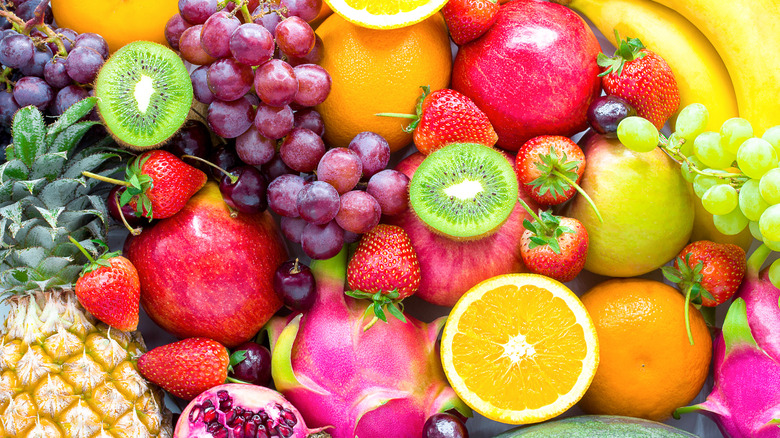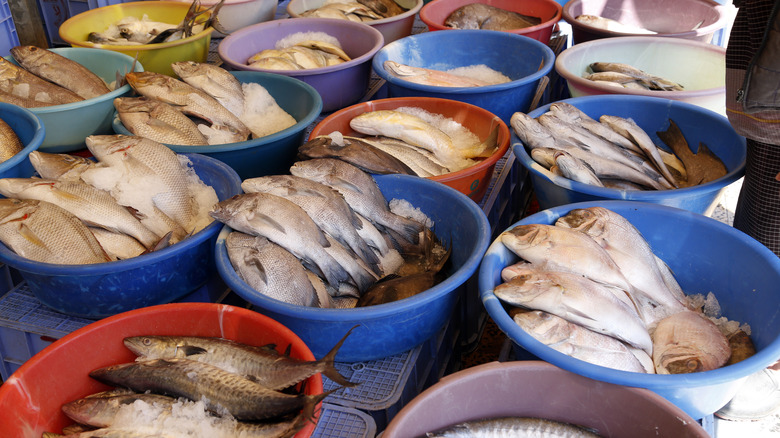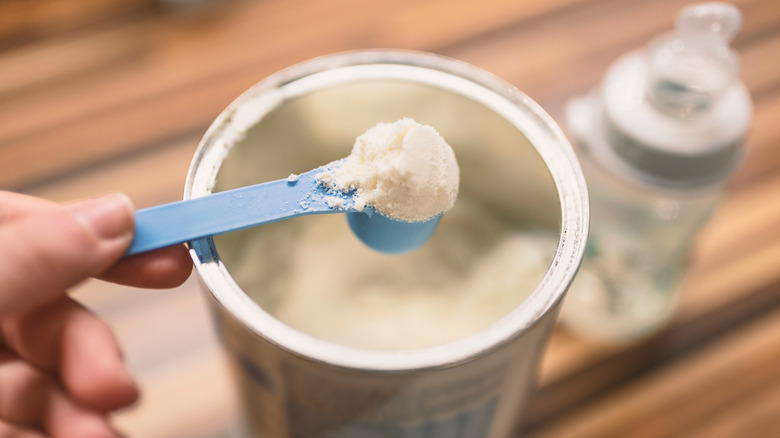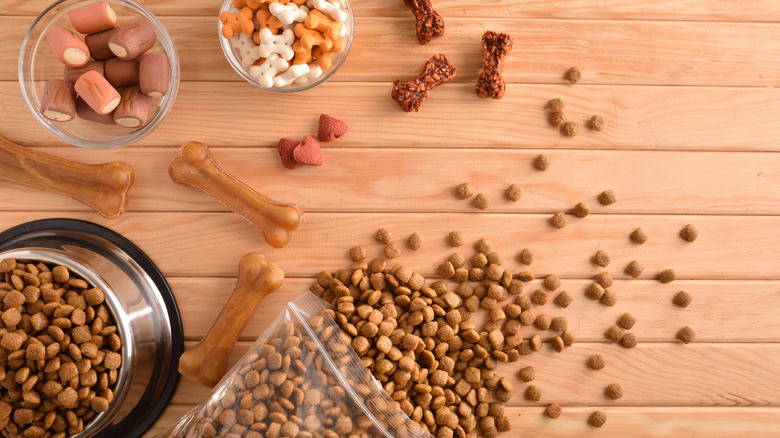Foods That Are Most Likely To Be Recalled
It seems like we hear about food recalls every week, and some types of food seem to be in the news more than others. It's true that there are foods that are at greater risk than others because of the way they're grown, the way they're processed, or even how we prepare them. According to the USDA Food Safety and Inspection Service (FSIS), there are a variety of categories for food recalls. The ones we worry about most are Class I recalls which carry the potential for sickness or even death. However, other recalls happen because of reasons like random materials found in food, import violations, being processed in a dirty environment, lack of inspections, and the potential for allergen contamination.
When it comes to foods that could make us ill or worse, listeria, E. coli, and salmonella are usually to blame. According to the FDA, the hospitalization rate for people consuming listeria-contaminated food is 94%, and 20% to 30% will die. WHO says that 10% of people infected with E. coli develop a disease and that it has a fatality rate of 3% to 5%. Meanwhile, a 2004 study in the Clinical Infections Diseases journal indicates that salmonella carries a 22% hospitalization rate. Luckily, the death rate for salmonella is negligible.
As you can see, food recalls can be serious, but they're also inevitable since no food is risk-free. Luckily, keeping a watch on recalls and engaging in safe food practices can help keep you safe.
Leafy Greens
The problems that leafy greens most often face come from E. coli and listeria. And with so many leafy greens like romaine lettuce and bagged salads not being cooked, they're more likely to make you deathly sick than foods you can cook to remove the pathogens. So any time officials detect one of these bacteria in leafy greens, it activates a recall. According to the CDC, leafy greens were the cause of almost 2,000 food-related illnesses between 2014 and 2020. Several of those illnesses were multi-state outbreaks, with 51 outbreaks happening between 2014 and 2018 and nine happening between 2019 and 2021.
One of the most likely ways leafy greens can become contaminated with E. coli is through contaminated irrigation water, especially if the farm is near places where livestock defecate. On the other hand, listeria is most likely to make its way to your leafy greens through contaminated machinery in a processing plant, making it easy to spread germs widely.
One way to keep yourself safer from microbes lurking on leafy greens is to buy whole heads and remove the outer leaves. Since it's the outer leaves that are the most likely to touch contaminants, the risk factor is lower the deeper you go into the leaves. Another option is to only buy leafy greens that have been grown indoors (such as in a hydroponics farm) rather than out in a field where they can come in contact with animal waste.
Soft cheeses
Cheese recalls tend to relate to listeria contamination. Any type of cheese can become contaminated with listeria. However, the CDC explains that soft cheeses have a higher likelihood of contamination because of their special qualities. The most recent multi-state listeria outbreaks from cheese all happened within soft cheeses like Camembert and queso fresco. Soft cheeses create the perfect breeding ground for listeria, since they don't have nearly as much salt or acid as hard cheeses, and they have a higher amount of moisture. If you decide to purchase unpasteurized soft cheese, you're putting yourself at an even higher chance of risk. If the listeria contamination happens early in the production process, pasteurization can kill it. Although there are certainly other points in the production process where it could acquire listeria after pasteurization.
One thing to understand about how listeria functions is that, unlike some pathogens, it actually continues to multiply and thrive in the refrigerator and freezer. While some bacteria stop growing at lower temperatures, listeria can continue to multiply anywhere within a temperature range of 29 to 113 degrees Fahrenheit. So your only recourse against the possibility of listeria-infected cheese is to serve it hot.
Preserved and smoked meats
Listeria is the villain bacteria when it comes to preserved and smoked meats. If the meat production process involves being cooked, fermented, or dried, it should kill the listeria. However, the problem comes by not getting the meat to a temperature to kill the bacteria or after the cooking process, either by picking up listeria within the factory itself or where you buy the meats (like a deli). Unfortunately, we tend to serve most of the preserved and smoked meats we buy without cooking them. It's important to know that refrigeration doesn't kill listeria. So any amount of listeria present in deli meats and smoked meats like smoked salmon is cause for a recall. However, the CDC says you can kill listeria if you heat it above 165 degrees Fahrenheit, which is a good argument for eating hot sandwiches rather than cold ones.
If you buy your meats from a deli, it's had that many more chances to be cross-contaminated with other meats through proximity or touch. Even if the person handling the meat is wearing gloves, it doesn't help if they've touched a pathogen-infected piece of meat before touching yours. As you can imagine, it's impractical for a deli employee to change gloves between every single order and every single type of meat they touch. Besides, anything in the deli could be contaminated, from the slicer to the countertop. There are plenty of places deli meats can pick up listeria if they're present.
Ground Beef
Ground beef recalls are generally related to E. coli. If a cow has E. coli in its intestines when it ends up in the slaughterhouse, there's a chance the bacteria can end up transferring to the meat itself during processing. With ground beef being processed together and containing the meat from a number of cows, it has the potential to spread the bacteria to a lot more meat. So if a sample of ground beef contains any E. coli, the production team assumes it has likely spread throughout all of it. Other cuts of beef can certainly be contaminated, but the processed nature of ground beef makes it more susceptible to risk. When Consumer Reports tested random packages of ground beef for bacteria in 2022, the deadly version of E. coli it found resulted in a recall of over 28,000 pounds of ground beef. Over the course of the year, the Food Safety Infection Service (FSIS) recalled a total of 409,649 pounds of beef.
While steak tartare has come back in fashion at restaurants again, you might think twice about ordering it since WHO says E. coli needs to reach temperatures above 158 degrees Fahrenheit to die, and salmonella needs to reach more than 150 degrees Fahrenheit. Rare hamburgers can also put you at risk if the meat is infected. For foods cooked with ground beef, a meat thermometer is your friend.
Onions
An onion recall can be especially tricky. For one thing, we often keep onions in our pantries for a while before using them, so we may completely miss a recall. But the other tricky part lies in the fact that there are plenty of places you can find raw onions besides just slicing them for sandwiches and salads. As such, there could even be a secondary recall linked to the initial onion recall because of foods containing raw onions, such as salsa, macaroni salad, or chicken salad.
The good news is that cooking onions can make them safe if they're contaminated with listeria or salmonella that they picked up in the field or factory. However, there's still a possibility of cross-contamination if you use the same knife and cutting board for cutting your onions as you did for other veggies, especially if you're not planning to serve all the veggies cooked. The best course of action for recalled onions in your kitchen is to throw them away.
Poultry
Poultry is a high-risk type of meat for recalls. According to the FSIS, chicken was recalled more often than any other meat in 2022, to the tune of 785,380 pounds – nearly twice as much as beef. All parts of poultry like turkey and chicken are susceptible to salmonella since plucking the feathers and cutting them into pieces facilitates the bacteria's spread throughout the bird.
Something you may not realize is that salmonella is so widespread in the poultry industry that it's actually legal for food companies to sell poultry even if they know it's contaminated with listeria. According to Consumer Reports, government regulations allow listeria to be present on a whole chicken in concentrations of 9.8% and 15.4% if it's a chicken cut into parts. As for ground chicken, up to 25% of it can be infected with salmonella. When Consumer Reports tested random packages of ground chicken in 2022, nearly a third of them contained salmonella, all of which were antibiotic-resistant types of listeria. The high possibility that any poultry you touch is infected with salmonella makes it extremely important to cook poultry thoroughly and wash your hands and any surfaces the bird or its juices have touched.
Fresh fruit
Fresh fruit recalls happen all the time, and the problem tends to come from salmonella and listeria. Even if you peel the fruit, the knife contacting the pathogens on the outside of the fruit can contribute to spreading it over the surface of the fruit's flesh. Then, if you cut into the fruit, you're spreading it even more. The good news is that washing produce with the right chemical can reduce listeria and salmonella to safe levels – with some caveats. It depends on what you use to wash the fruit, and using enough of the chemical may cause the produce to become carcinogenic.
The problem with fresh fruit tends to come from multiple sources. It can happen when farmers grow fruit near animal feedlots, which provides a contamination risk from irrigation or even the dust flying around in the air. In the case of the 113 million pounds of peaches recalled in 2020, the strain of salmonella on them were ones you normally see infecting beef and poultry. Another problem that can arise with fruit comes when you buy fruit like melons that come packaged and pre-cut. Any bacteria-laden machinery used to cut and process the fruit can transfer it to multiple pieces of fruit. Buying whole fruit can help you avoid this scenario. Papaya has also been a risky fruit lately. Those imported from places like Mexico aren't subject to the same FDA production inspection process they would be if they were grown in the U.S.
Flour
Recalls on flour are more common than you'd think. Most of us have the idea that we shouldn't eat raw cookie dough or lick cake batter off of beaters because of potential bacteria in eggs. However, the real baddie in this scenario is often flour. When we say "flour," we're also including products that contain raw flour, like premade dessert mixes like brownie and cake mixes, as well as pancake and waffle mixes. When grains grow out in the fields, they have plenty of chances for contamination with pathogens like E. coli and salmonella. The culprits may be livestock living nearby or even wild animals like deer and birds that visit the fields. Unfortunately, flour doesn't undergo any sort of cooking process before you get it in the store – just a milling process to grind the grains. Contaminants it may pick up in the field or at the mill end up in your flour.
You may think you're safe from pathogens in uncooked flour if you use it in baking and don't eat uncooked batter or dough. However, when you think about the nature of flour, you'll realize how easy it is for it to become airborne and contaminate surfaces throughout your kitchen. Sometimes just opening the bag is enough to send flour products flying. In case of a recall, be safe and throw the whole package away.
Seafood
A 2023 study in the Journal of Food Protection revealed that there were over 2,400 recalls of seafood in the 20 years between 2002 and 2022. Violation of Current Good Manufacturing Practices (CGMP) contributed to 74% of the recalls that occurred during those 20 years. CGMP violations can relate to a variety of things including diseases, protective clothing, sanitation and cleanliness, protection against allergens, equipment maintenance, processing environment, warehousing, and distribution.
Most of the seafood recalls during those 20 years (70%) were from fish with fins as opposed to shellfish or crustaceans like shrimp. Interestingly, 22% of the recalls were from a singular species: salmon. Smoked salmon seemed to be the most often recalled fish species since not all companies were engaging in safe cold-smoking practices.
During the 20 years, nearly 50% of the recalls were Class I recalls, which were enacted to prevent illnesses, hospitalizations, and deaths. While salmonella and E. coli can also be a concern with seafood, 30% of the Class I recalls were related to listeria infections. Furthermore, potential allergens not listed on the package were responsible for 34% of the recalls. In half of the allergen-related recalls, the culprits were undeclared milk and eggs in the product or facility.
Baby formula
One of the most terrifying food recalls is for baby formula. Parents buy everything from car seats to electrical outlet plugs to keep their babies safe. When the danger comes from something a baby needs to survive, like formula, it can be devastating. Formula makers operate under an abundance of caution to ensure their products are safe for babies, so sometimes the recalls are fairly extreme.
The 2023 Enfamil ProSobee Simply Plant-Based Infant Formula recall was because of a fear that it may contain the Cronobacter sakazakii bacteria, which can cause infants to become extremely sick or even die. The same bacteria was the culprit in the enormous 2022 recall of formula from Abbott Nutrition that caused four hospitalizations and two deaths. It was actually this recall that brought about the baby formula shortage that had parents obsessively checking grocery store shelves so that they could feed their hungry babies.
Foods containing undeclared allergens
Any time you scroll through the most recent food safety recalls at FoodSafety.gov, you'll notice that a majority of recalls are related to "undeclared allergens." Usually, these are related to packaging that doesn't reveal that the food may contain common allergens like milk, eggs, soy, nuts, fish, or wheat. If the food has a component made with one of these allergens, or it's made in a facility that processes foods with these allergens, the packaging should say so. While there might not actually be any of these allergens present in the food at all, the USDA and FDA are diligent to recall them just in case it could cause someone to have any type of allergic reaction. Since some people have deathly allergies, not labeling the package properly is a serious offense.
If foods are recalled because of undeclared allergens, it's not dangerous to the large majority of people. However, those who are sensitive to the undeclared allergens in the product are asked to either throw it away or return the product for a refund.
Dog food
Just like recalls for human baby food, recalls for food for your fur babies can be quite devastating. Far too many of us have experienced our beloved dogs dying as a result of tainted dog food. Within a 10-year time span, from 2012 to 2022, there were 223 dog foods recalled. In an average year, 22 types of dog food end up subject to a recall, although the numbers can be higher or lower each year. For example, there were only nine recalls in both 2017 and 2016. Meanwhile, there were a whopping 39 dog food recalls in 2018.
The types of dog foods that are recalled range from dry foods to wet and raw foods. However, it also applies to items dogs consume like treats, liquid probiotics, and rawhide chews. The problems with these dog foods are vast. While salmonella and listeria are among the contaminants, there are other problems as well, including mislabeling issues, potentially toxic levels of certain vitamins, Aflatoxin levels that were too high, safety and sanitation violations, and mold toxins. Keep an eye out for dog food recalls just as much as human food recalls because they're happening constantly.
